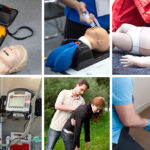Many people question whether they should even bother putting their CPR certification on their resume. The answer is undoubtedly yes for a few reasons.
CPR certifications are mandatory for candidates applying for medically related positions. If these professionals don’t include a CPR certification on their resume, they can immediately be eliminated from the running. This typically happens for positions with a large number of applicants. Eliminating those without CPR certifications is an easy way to thin the herd and to determine if the candidate is actually qualified.
Additionally, putting a CPR certification on your resume is beneficial even if you aren’t applying for a medically related position. Including this certification displays your dedication to fulfilling your social responsibility and going above and beyond what is required of you.
American CPR Care Association is here for all your CPR certification needs. We offer both blended and online CPR certifications and are here to help you save lives. We make earning your CPR certification and bolstering your resume easy. Continue reading to learn more about how our course offerings boost your resume.
Is CPR a Skill to Put on Your Resume?
Any medical or health resume can be boosted with CPR and First Aid certifications. These certifications can push your resume to the front of the list if the steroids for sell decision comes down to you and another candidate without a CPR certification. Employers can quickly toss resumes aside that don’t have CPR certifications.
Should I Put CPR Certification on My Resume?
Yes. You should put CPR on your resume regardless of whether you are in a health-related profession. However, it’s especially critical to put this certification on your resume if you are applying for a medical-related field. If you aren’t, CPR certifications demonstrate a willingness to help community members and to commit to skills outside of your immediate scope of practice that benefit others.
Where to Put CPR Certifications on Your Resume
There are many placement options when trying to find out where to put your CPR certification. Since CPR is not a license, but rather, a certification, you will never have to place it after your name.
If you put the certification in the “Certification and Training” section, you should list it in reverse chronological order with other education and training. The exception to this rule is if you list them with academia, you should always display your degrees first.
Regardless, you should always embolden your certifications. The following guidelines are helpful tools to use when considering placement:
Does Your Job Require CPR Certification?
If the job posting requires CPR certification, you should put it near the top of the resume. The following represents some options for you:
- Next to your name- Though you can place licensures next to your name, this does not apply to CPR certifications because it is not a license.
- Professional Summary- Sometimes, you can specify that you are CPR-certified in the section before your “Work History” or “Experience” section.
- Objective- If you do not have enough experience to include in a professional summary, you can use an “Objective” heading. People seeking to change their careers may also have an “Objective” section.
Adding a Section for Certificates
Adding a section specified for only your certifications will make them stand out on your resume. However, if CPR is the only certification you have, it might appear strange. If this is the case, you should try to add training courses to bolster the section and label it “Certifications and Training.”
Older Certifications
If older certifications are irrelevant, you should not include them. There are a couple of exceptions:
- If your certification is expired or pending, including it depends on your industry.
- If your certification is expired, then you will need to get recertified before entering the certification for your job.
- You should also include the dates you had your certification and add the completion date if applicable.
- If you are in the process of earning your certification, you should include the target completion date.
CPR Certification on Resume
Anyone in the medical field acting as a first responder should include their CPR certification on their resume. Medical professionals, however, aren’t the only people who need to put their CPR certification on their resume. Teachers should also know how to perform CPR as well as fitness professionals.
Placement of the CPR certification depends on a few components. Generally, you can put your certification in one of four areas:
- Summary: If CPR certification is mandatory, you can start by specifying that you are CPR-certified
- Extra: If the CPR certification is extra, you can add “also CPR certified” by the association that certified you in the “Work Experience” section.
- Objective: If you are in the medical field, it’s acceptable to start with something akin to the following example: “CPR-certified EMT looking to apply first responder skills to [company title].
- Certification and Training: The format should look something like the following: “CPR-certified, American CPR Care Association, Issued June 19th, 2020, Expires June 19th, 2022.”
BLS Certification on Resume
American CPR Care Association also offers Basic Life Support Certification programs. First responders and others might be interested in taking Basic Life Support classes. Additionally, many medical professional positions require Basic Life Support certifications. Your certification should look similar to the CPR certification placement.
How Long Does It Take to Get Your CPR Certification?
CPR/AED courses are typically around three hours long. They can be either shorter or longer depending on the association, whether people renew their certification in the class, and how small the group-size. Additionally, if you earn your CPR certification online, you can take as much or as little time as you want with a CPR certification.
What Is the Difference Between CPR Certification and First-Aid?
First-aid refers to a wide range of practices and responses, whereas CPR certifications are specified and focus primarily on responding to cardiac arrest and drowning emergencies. FIrst-aid classes can range from things like treating burns, to tourniquet techniques. CPR classes teach you exclusively how to respond to someone in cardiac arrest and how to perform the life-saving technique of CPR.
What’s the Difference Between BLS and CPR Certification?
You might wonder, “is CPR certification the same as BLS?” BLS, or Basic Life Support, is essentially healthcare-provider level CPR. It is much more specified and teaches healthcare professionals how to work in teams to deliver CPR. The audience for each class is different as well. BLS is intended primarily for only healthcare professionals because the situations it teaches only occur in medical settings.
CPR certifications teach average citizens how to respond to cardiac arrest emergencies and they aren’t as specified for medical professional settings.
The Four Elements of Basic Life Support
The four elements of Basic Life Support are as follows:
- Early access
- Early CPR
- Early defibrillation
- Early advanced cardiac life support
What Are the Steps of CPR?
The steps of CPR are as follows:
- Check for a response- shout, “are you okay?”
- Call for help- tell someone to call 911 and to try and find an AED.
- Start chest compressions (chest compressions should not exceed 120 per minute and you should perform them no deeper than 2”).
- Perform two rescue breaths.
- Resume chest compressions.
- Await first responders’ assistance.
Conclusion
Put your CPR certification on your resume today! CPR certifications are valuable certifications to display on your resume whether you’re applying for a medically related position or not. Earning your CPR certification shows potential employers that you’re willing to take initiative and protect your community, potentially saving lives.
American CPR Care Association is here for all your CPR certification needs. Our online and blended CPR certification courses teach you all you need to know to effectively and safely respond to cardiac arrest emergencies.
Register today to begin earning your CPR certification so you can look more attractive on your resume.







